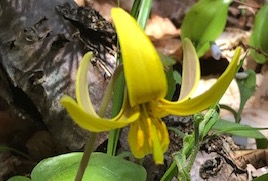First Foray, 2019: Mt. Greylock
- Kathleen

- May 29, 2019
- 3 min read
Updated: Jul 3, 2019
Spring in New England is sprung--or working on springing. The first hike of the season took us to the Berkshires and Mt. Greylock--Massachusetts' tallest peak. We started from the Campground Parking Lot, at about 2,500 feet, and hiked to the summit at 3,491 feet-- a not-very-impressive gain of about a thousand feet.
Yet the change in climate was noticeable. On the valley floor, all was green and the foliage was dense. At the summit, many trees had not yet leafed out. So from the base of the mountain, the peak looked brown and dormant. (You can see the gradation in color in the photo, if you look carefully between the pine trees.) It was a visible reminder that in the spring, a hike up a mountain is like a trip back in time, growing-season-wise. (The process reverses in fall.) Steven tells me that every 1,000 feet of altitude is comparable to 500 miles of latitude, or distance north/south. So, in climbing 1,000 feet, we covered as much distance, temperature and climate-wise, as if we had walked from Williamstown to 250 miles north of Montreal! (That sounds a little more impressive!) As at the top of Mt. Greylock, spring is just beginning to unfold there.
Which turned out to be a boon! At the start of the hike, the trout lilies (also known as adders' tongues) had already flowered and faded. By the time we got to the top, they were in full bloom! Look at those beauties with their butter-yellow flowers and mottled leaves. They are one of the first plants to flower in the woods of northeastern United States--a true harbinger of spring. Learn more here:
The raw bulbs of these little lovelies were one of the first wild edibles I ever ate, so they have a special place in my heart. (The leaves and flowers are also edible, but don't overdo it--they may make you throw up.) Trout lilies are special for another reason, too: they were a formative part of my growing up as a woods-woman. I remember digging one up and bringing it home to my mother to identify. My mother was (and still is) handicapped, and cannot walk in the woods. But she has a vast, encyclopedic knowledge of plants, which she fortunately was willing to pass on to me. I was always bringing home plants (and animals, and fish, and birds, and snakes) to learn from her. (She was not too fond of the snakes.)
Apparently trout lilies get their name from the brown mottling on their leaves, but during this conversation with my mother, my father noted that the flowers bloom at the same time as when trout fishing season begins. This naming of plants in relation to other features of the season in not uncommon: case in point, the shadblow tree, which flowers when the shad (a small, herring-like fish) begin running. The shadblow is one of the earliest trees to flower, though its flowers are a little stinky. https://www.friendsofthewildflowergarden.org/pages/plants/serviceberry_canadensis.html
But apparently, its fruits are edible! Who knew? I didn't, before looking it up.
I'm learning too, and hope you will learn along with me as we continue our "walks in the woods."
Oh, and as if trout lily/adders' tongues didn't already have enough names: it's also known as dog-tooth violet. This plant is not a violet--but violets will be the star of our next post.
Happy Spring, happy (plant) hunting, happy eating!














Comments